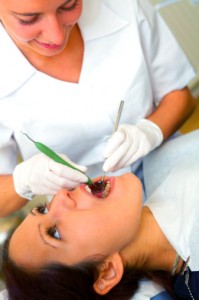What Is The Dental Hygienist Doing to Your Mouth?
Understanding the different tools a dental hygienist uses will help you tolerate cleanings better.

When you have a gentle dental hygienist, it’s easy to trust the hygienist to do whatever they need to do to get your teeth nice and clean. But if you happen to visit some other dental clinic besides California Dental Group and end up with a rough or careless hygienist, you may begin to wonder what all the poking and prodding is for. Here’s a brief overview of the cleaning process that will help you understand what’s going on.
Brushing & Flossing
Naturally your dental hygienist needs to brush and floss your teeth in order to clean them. But the tools and techniques the hygienist will use may not be what you’re used to at home. First of all, the hygienist doesn’t use a toothbrush. Instead they use an electric polisher that doesn’t actually have bristles. A specially formulated toothpaste is used with the polisher to help remove stains, leave your teeth smooth and clean, and help make it harder for plaque bacteria to attach for a while. Your hygienist will also floss your teeth using the proper flossing technique—something you may need to get a refresher course on yourself!
Tartar Removal
Here’s where some patients start to feel a little bit on edge. The dental hygienist needs to remove plaque that has hardened into tartar from your teeth both above and below the gum line. This is a very important activity because tartar can otherwise contribute to gum disease. The only way to remove tartar is at the dentist—some toothpastes can control future tartar buildup but they will not remove existing tartar. While ultrasonic scaling equipment can help to break down tartar, there will likely be a few stubborn spots that need to be attacked with hand tool. Your dental hygienist will use a tool with a pointed hook to remove tartar above the gum line, and a tool with a rounded end to clean below the gum line.
Gum Pocket Measuring
In addition to cleaning your teeth, the dental hygienist will also help examine your mouth to identify any concerns that the dentist will need to evaluate during your routine dental exam. One part of this process that many patients don’t like is measuring the gum pockets. The hygienist will gently insert a special tool beneath the gum line for this purpose. A measurement of 1 to 3 mm is normal, while 4 mm will likely cause a warning about better oral care. A measurement of 5 mm or more will mean you are at risk for gum disease and you may need to get a special periodontal deep cleaning to clean out all your gum pockets.
Remember, at California Dental Group our expert dental hygienists are all very gentle. You can always have them stop and answer any questions you may have about the different elements of your routine dental cleaning.




